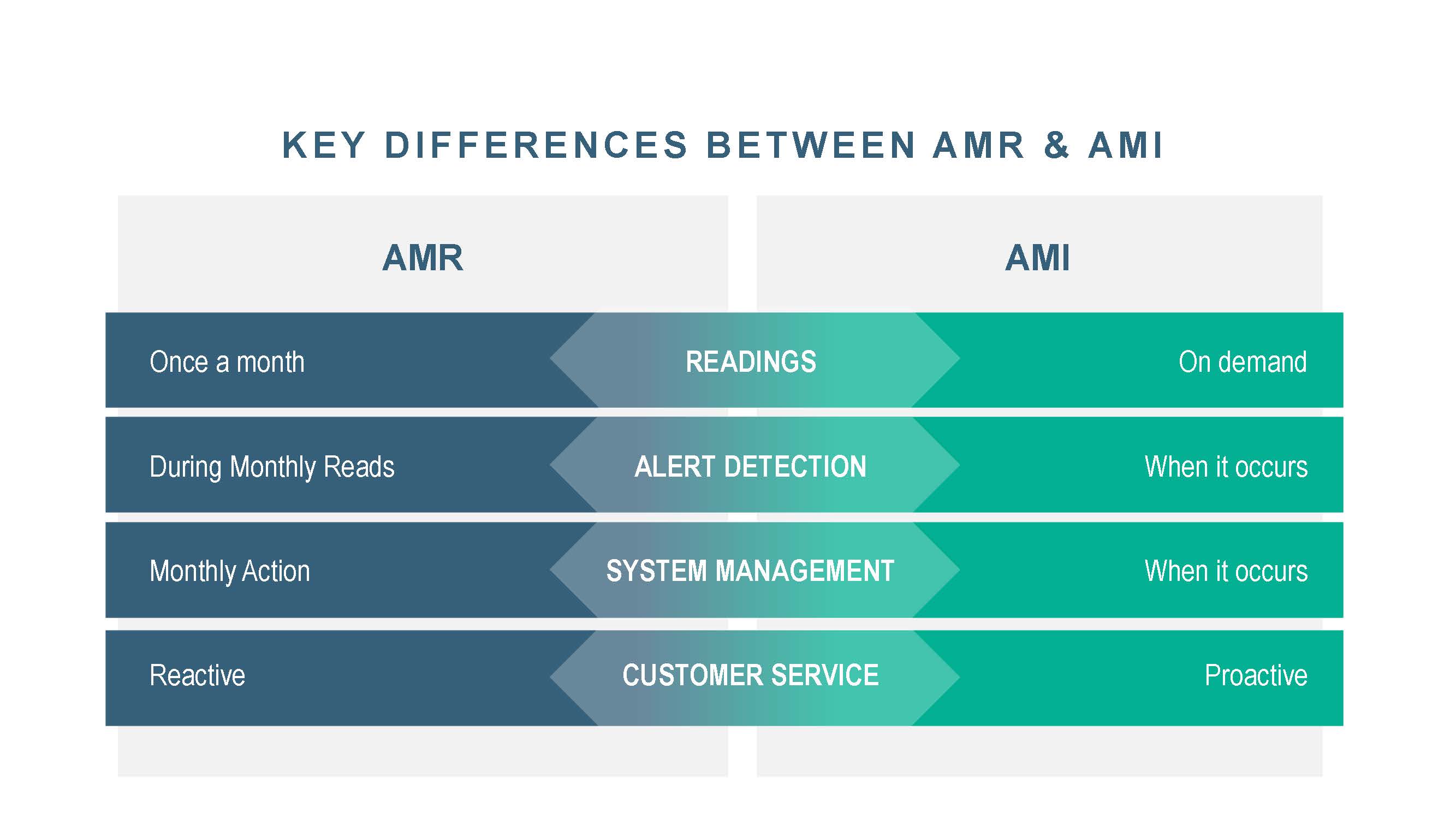KSA ENGINEERS DISCUSS AUTOMATED METER READING AND ADVANCED METERING INFRASTRUCTURE.
For many communities today, the meter reading process hasn’t changed much since the 1950s. Back then, water meter reading was a completely manual process. Workers read register dials and recorded their readings in a ledger book. Then, a billing clerk would compute the water usage and issue bills to customers. Although this is still a common process in many communities, it is extremely time-consuming and susceptible to errors that can cost a municipality (and its customers) valuable time and money.
Since the 1950s, metering technology has advanced considerably. The 1980s brought the birth of drive-by and walk-by automated meter reading (AMR) systems. Radio frequency technology was developed that connected meter registers to a radio frequency transmitter. Handhelds or mobile collectors were used to obtain meter readings. These readings were then downloaded from the collector into the billing software for the electronic processing of bills. This technology is essentially the basis of most automated meter reading systems today.
The first fixed network reading systems were also introduced in the 1980s. These early advanced metering infrastructure (AMI) systems utilized telephone lines for communication between the utility office and the water meters. In the 1990s and 2000s, fixed network systems started using radio frequencies for communication, making AMI systems more affordable than first generation systems and easier to implement in remote areas.
WHY SHOULD YOU CONSIDER AN UPGRADE?
- To reduce revenue loss. If you are experiencing losses in revenue due to water theft, unaccounted usage and/or leaks, you should consider an upgrade. The older your system is, the more likely it’s inaccurate.
- To address aging infrastructure. If your water infrastructure dates back 20, 30, or 40 years, you should consider an upgrade. Across the US, water infrastructure dates back to the 1940s and earlier; and many of these systems have only been upgraded on an as-needed basis. As a result, many water systems are running on crumbling infrastructure that’s inaccurate and inoperable.
- To conserve water. If you want to conserve water in your community, you should consider an upgrade. Water shortages have become a growing concern in recent years. A more sophisticated water metering system can enable a utility provider to conserve water through the use of more accurate metering and billing. An upgraded system can also provide the basis for a new rate structure that can conserve water and provide a higher stream of revenue.
- To enhance water management. If you want to reduce the time associated with reading meters and/or you want real-time data, you should consider an upgrade. Updated meter reading technology and infrastructure can drastically enhance your ability to manage the operation of your water system. You can get more information, faster – even from remote locations.
- To improve customer service. If you want to provide better service to your customers, you need to consider an upgrade. Today’s customers are accustomed to instant gratification. If they have a problem or question, they want it resolved quickly. Updated water metering technology and infrastructure will allow you to proactively identify and prevent issues.
- To improve operations and maintenance. If you want to free-up (or potentially reduce) your workforce, you should consider an upgrade. For smaller systems, meter readers typically have other tasks they are responsible for; whether it is repairing leaks, flushing lines, or operating the system, these employees have to wear several hats. The installation of an updated metering system and infrastructure would free up a lot of their time to better operate and maintain the water system, or be re-assigned to other tasks. Larger systems usually have dedicated meter readers. The installation of an updated water system will allow these workers to be reallocated to other tasks or positions.
WHICH SYSTEM IS BEST FOR MY COMMUNITY?
About AMR
Automated meter reading (AMR) is the automatic collection of water meter data such as water consumption, diagnostic, and status data. The AMR process also includes the transfer of collected data to a central database for billing, troubleshooting, and analysis. AMR systems can be walk-by or drive-by, but regardless of how the information is collected, the communication is generally one way. The meter talks to the meter-reading device, but the device cannot send a command back to the reader. There are a few manufacturers that do have two-way communication, but for the most part, AMR systems are a one-way communication system.
How AMR systems work. AMR systems typically include a water meter equipped with a battery-powered radio frequency transmitter that transmits the meter readings and alerts. The signal from the transmitter at the meter is received by a mobile collector that is installed on the utility provider’s meter reading vehicle. The meter reading data is captured by route software installed on a laptop in the vehicle. Once all the meter routes have been driven, the collected data is downloaded onto a thumb drive and uploaded onto the utility provider’s computer for bill generation.
The deciding factors. If you are mostly interested in reducing the time associated with meter readings, an AMR system is probably the best choice for you. Not only do AMR systems drastically reduce the time it takes to read meters, they also require less initial capital investment to install. If you are a smaller system, or one with less money to spend upfront, an AMR system may be a better fit. Because AMR systems are automated, they are more accurate. AMR systems also provide more information for system management like monthly meter alerts to notify you of leaks and water theft. While monthly alerts are an incredibly useful feature, its reactive nature can allow issues (such as a leak) to persist throughout the duration of the billing cycle. Many AMR systems can also be migrated into an automated metering infrastructure (AMI) system if/when the need (and resources) become available.
About AMI
Advanced metering infrastructure is a metering system that records water consumption data and provides frequent transmission of that data over a fixed base communication network to a central location point for analysis and real-time control. Transmission intervals vary depending on the manufacturer, but are often adjustable. Typically, AMI systems provide hourly data once a day, but data can be provided on-demand as well.
How AMI systems work. Varying significantly by manufacturer, AMI systems include a water meter that is equipped with a two-way, battery-powered radio receiver that allows the meter to send and receive data through existing cell phone towers or Ethernet infrastructure. Repeaters and data collectors send and receive data from the billing office to the metering end points. These repeaters and collectors are installed throughout the water system to provide overlapping coverage of the entire service area.
The deciding factors. If you are interested in reducing the time associated with meter readings, and you want real-time information about your water system, an AMI system may be the best choice for you. While this system costs more initially, AMI systems can provide alerts about incidents as they occur, making it the ideal choice for utility companies that want to provide proactive service to their customers. AMI systems can allow you to notify your customers of an issue that can be corrected before the next billing cycle, avoiding an unnecessarily high water bill. The two-way communication that AMI systems employ is what makes on-demand meter readings possible. It also allows the immediate download of software and firmware updates that essentially guarantees the viability of your AMI system for years to come.

POTENTIAL ISSUES WITH AMR/AMI SYSTEMS
- Misreads. No system will be 100% accurate, 100% of the time. Misreads will happen and the utility owner will have to manually read some meters and/or investigate why some meters are not transmitting.
- Limited battery life. With lithium ion batteries (which are standard) battery life is around 20 years. They generally include a 10 year full replacement warranty, and a 10 year prorated warranty.
- Harsh environments. Meter boxes are not the ideal location to install electronic equipment. They are dirty, wet, and vulnerable to insects and customer tamper. The electronic equipment is filled with a shock and moister resistant compound that helps prevent water damage, but electronics are still susceptible to damage and tamper.
- Managing expectations. The utility company needs to be financially prepared to pay for a system. We do not advise relying on expected revenue increases to pay for the system, because a water system’s usage cannot be predicted. There are simply too many variables that vary year to year depending on weather, rates, etc. These systems will reduce your labor costs, but the impact on water sales will vary system to system.
- Recurring annual costs. These costs vary by manufacturer, but AMR systems typically have an annual software maintenance fee. AMI systems generally have more annual costs associated with them; these fees can include items like, cellular service fees, software maintenance and license fees, and technical support fees. Identify and plan for these fees upfront.
- Cost variations. Topography and the size or shape of a service area can drastically impact the cost of an AMI system. These items are directly related to the amount of collectors and repeaters required to obtain the data. Propagation studies are performed by AMI manufacturers to determine the amount of infrastructure required. This is not an issue with AMR systems because all the meter routes are driven.
CONCLUSION
There is much to consider in the world of water system management and one size does not fit all. The first step is to work with a knowledgeable consultant to help determine your needs and objectives. Your consultant can help you evaluate your options, test your existing system, and develop a smooth implementation strategy.
